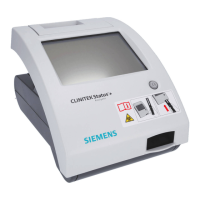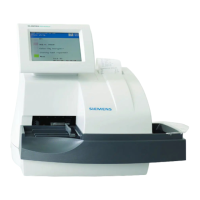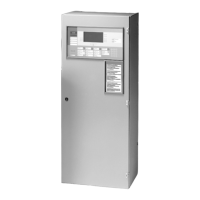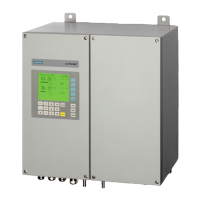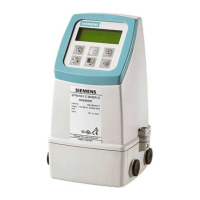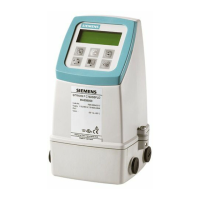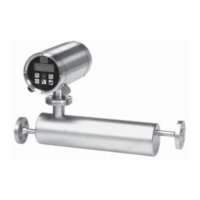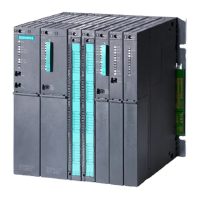Do you have a question about the Siemens CLINITEK Status+ and is the answer not in the manual?
Defines the purpose and scope of the CLINITEK Status+ Urine Chemistry Analyzer.
Explains physical characteristics measured by urinalysis strips and their use.
Provides information on unpacking and installing the analyzer.
Details the main hardware components of the analyzer.
Describes the user interface and touch screen operation.
Explains interaction with the analyzer via the touch screen.
Details how to input data using on-screen keyboards.
Guides through performing a quick test with a urinalysis strip.
Details the procedure for conducting a urinalysis strip quick test.
How to view and interpret results of a quick urinalysis strip test.
Guides through performing a quick test using an hCG cassette.
Procedure for conducting an hCG cassette quick test.
Guides through performing a full test with a urinalysis strip, including data entry.
Details on entering operator and patient data for a full test.
Procedure for conducting a full urinalysis strip test.
Guides through performing a full test with an hCG cassette, including data entry.
Procedure for conducting a full hCG cassette test.
Explains the automatic calibration process of the analyzer.
Instructions for cleaning the white calibration bar on the test table.
Explains the purpose and importance of Quality Control (QC) testing.
Guidance on performing QC tests for urinalysis strips.
Guidance on performing QC tests for hCG cassettes.
Procedure for weekly cleaning of the test table and its insert.
Detailed steps for cleaning the white calibration bar.
Guidelines for disinfecting the test table and insert.
Instructions for replacing the analyzer's batteries.
Explains different types of error messages displayed by the analyzer.
Details errors that need immediate correction to enable testing.
Provides a table of error codes, messages, and corrective actions.
Discusses common operation issues and their solutions.
Guidance on when and how to seek technical support.
A checklist to help diagnose and report analyzer problems.
How to search, view, and print stored patient test results.
Procedure to transfer all stored test results to a PC or host computer.
Steps for removing stored patient test results from the analyzer.
Lists the default configuration options for the analyzer.
How to modify default system configuration settings.
Instructions for selecting the desired system language.
Procedures for setting up and removing a password.
How to configure operator and patient information prompts.
Options for customizing operator, patient, and sample appearance settings.
How to adjust the analyzer's date and time settings.
Overview of how to modify various instrument settings.
How to select different formats for displaying and printing test results.
Steps to upgrade the analyzer's software using a memory card.
How to run diagnostic tests on analyzer components.
Guidelines for handling laboratory biohazards.
Procedures to prevent accidental contamination in the lab.
Criteria for when to call technical support for assistance.
Lists available supplies and optional equipment for the analyzer.
Lists available replacement parts for the analyzer.
Summarizes design specifications and test results summary tables.
Details operating temperature, humidity, altitude, and pollution degree.
Specifies power requirements and battery operation.
Table of symbols on the analyzer, power supply, carton, and supplies.
Explains icons that appear on the analyzer's screen.
Defines hardware terms commonly used with the analyzer.
Defines software terms commonly used with the analyzer.
Lists common acronyms used in the manual and with the analyzer.
Defines the purpose and scope of the CLINITEK Status+ Urine Chemistry Analyzer.
Explains physical characteristics measured by urinalysis strips and their use.
Provides information on unpacking and installing the analyzer.
Details the main hardware components of the analyzer.
Describes the user interface and touch screen operation.
Explains interaction with the analyzer via the touch screen.
Details how to input data using on-screen keyboards.
Guides through performing a quick test with a urinalysis strip.
Details the procedure for conducting a urinalysis strip quick test.
How to view and interpret results of a quick urinalysis strip test.
Guides through performing a quick test using an hCG cassette.
Procedure for conducting an hCG cassette quick test.
Guides through performing a full test with a urinalysis strip, including data entry.
Details on entering operator and patient data for a full test.
Procedure for conducting a full urinalysis strip test.
Guides through performing a full test with an hCG cassette, including data entry.
Procedure for conducting a full hCG cassette test.
Explains the automatic calibration process of the analyzer.
Instructions for cleaning the white calibration bar on the test table.
Explains the purpose and importance of Quality Control (QC) testing.
Guidance on performing QC tests for urinalysis strips.
Guidance on performing QC tests for hCG cassettes.
Procedure for weekly cleaning of the test table and its insert.
Detailed steps for cleaning the white calibration bar.
Guidelines for disinfecting the test table and insert.
Instructions for replacing the analyzer's batteries.
Explains different types of error messages displayed by the analyzer.
Details errors that need immediate correction to enable testing.
Provides a table of error codes, messages, and corrective actions.
Discusses common operation issues and their solutions.
Guidance on when and how to seek technical support.
A checklist to help diagnose and report analyzer problems.
How to search, view, and print stored patient test results.
Procedure to transfer all stored test results to a PC or host computer.
Steps for removing stored patient test results from the analyzer.
Lists the default configuration options for the analyzer.
How to modify default system configuration settings.
Instructions for selecting the desired system language.
Procedures for setting up and removing a password.
How to configure operator and patient information prompts.
Options for customizing operator, patient, and sample appearance settings.
How to adjust the analyzer's date and time settings.
Overview of how to modify various instrument settings.
How to select different formats for displaying and printing test results.
Steps to upgrade the analyzer's software using a memory card.
How to run diagnostic tests on analyzer components.
Guidelines for handling laboratory biohazards.
Procedures to prevent accidental contamination in the lab.
Criteria for when to call technical support for assistance.
Lists available supplies and optional equipment for the analyzer.
Lists available replacement parts for the analyzer.
Summarizes design specifications and test results summary tables.
Details operating temperature, humidity, altitude, and pollution degree.
Specifies power requirements and battery operation.
Table of symbols on the analyzer, power supply, carton, and supplies.
Explains icons that appear on the analyzer's screen.
Defines hardware terms commonly used with the analyzer.
Defines software terms commonly used with the analyzer.
Lists common acronyms used in the manual and with the analyzer.
| Display | LCD |
|---|---|
| Sample Type | Urine |
| Measurement Method | Reflectance photometry |
| Type | Urinalysis Analyzer |
| Test Types | Urine Chemistry |
| Connectivity | RS232 port |
| Weight | 5.0 kg |
| Power Supply | 100-240 V AC, 50-60 Hz |
| Data Storage | Up to 200 patient results |
| Test Parameters | Leukocytes, Nitrite, Urobilinogen, Protein, pH, Blood, Specific Gravity, Ketone, Bilirubin, Glucose |
| Test Strips | Multistix and other compatible strips |
